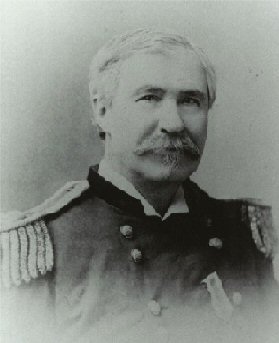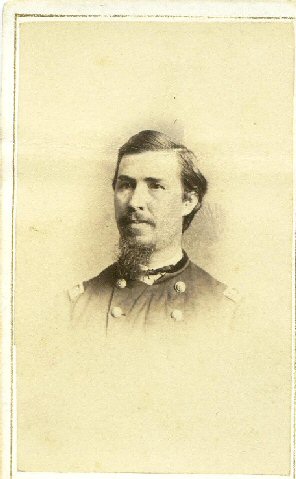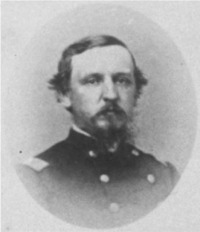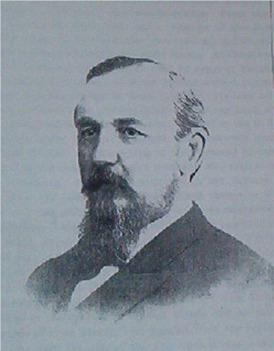Born at Liberty, Indiana, January 20, 1835, he served as Private, 3rd Battalion, D.C. Infantry, April-July 1861; Captain, 19th Iowa Volunteer Infantry, August-December 1862; Paymaster, U.S. Volunteers, December 18, 1862 to April 8, 1867.
|
Thaddeus Harlin Stanton, was born 30 Jan
1835 in Liberty, Union County, in the State of Indiana. He is the first son of Seth and Phebe
(Leonard) Stanton. He first joined the Union Army with the 15th
Iowa Regiment in 1861. In March on the 17th day of 1876 he fought at the “Battle of Powder
River”. Stanton was the chief scout serving with General Crook. To quote the correspondent
Robert Strahorn, a famous newspaper columnist who wrote about the March 17th battle- “Colonel
Stanton, having virtually finished his duties as chief of scouts by piloting the command to the
camp of the foe, could have consistently remained at headquarters, but, dismounting, shouldering
his long rifle and advancing at the head of Captain Moore’s column, it was quite evident that
he didn’t propose to stop until the fight ended, at least” (“Battles and Skirmishes of the
Great Sioux War, 1876-1877 The Military View”). Stanton and his scouts drove 700 captured
Indian ponies, horses and mules twenty miles and turned them over to Colonel J. J. Reynolds. The
Indians retook them the next day. Reynolds was eventually forced to resign for this major
blunder.
Thaddeus later obtained the rank of General, and was a paymaster.
The Fifteenth Regiment Iowa Volunteer Infantry, composed of more than a thousand men, from more than a score of counties in the state, recruited in the fall of 1861 and the winter of 1861-2, was as slow in its enrollment as the contemporaneous movements of the Army of the Potomac, which, but for its splendid parades, would have appeared to stand still and quiet like a stockade. The rendezvous was at Keokuk, whither some of the companies proceeded in the autumn of 1861, and where, from time to time between the first of November and the latter part of February, 1862, all the companies were mustered into the service of the general government. But it was in the month of March that the regiment was fully organized, and became a recognized part of the grand volunteer army of the Union. Hugh T. Reid, of Lee County, was the commanding officer, William Dewey, of Fremont, lieutenant-colonel, and William W. Belknap, of Lee, major. These had all been commissioned before the command was filled up, and the staff was also organized in advance of the complete formation of the regiment. George Pomutz, an Hungarian of Decatur County, who had seen service on the plains of Europe, where he fought for his country's nationality, was adjutant; John M. Hedrick, quartermaster; Dr. Samuel B. Davis, surgeon; William H. Gibbon, assistant; and Rev. William W. Eastabrook, chaplain. Company A was recruited chiefly in Clinton and Linn counties: Captain J. W. Kittle, Lieutenants Before the regiment left "Camp Halleck" for the field, the companies which had reached the rendezvous received thorough instruction and some lessons in the battalion drill, for the most part under the supervision of Major Belknap, a natural soldier, who, however, received willing assistance from the colonel and lieutenant-colonel, so that it may be safely said there were few regiments left Iowa which had attained a greater efficiency in drill, or a better notion of discipline than the Fifteenth. The 19th of March, the regiment left the rendezvous for the seat of war. It was a stormy day. It rained, and the streets of Keokuk were muddy. Nevertheless, there was a large concourse of citizens at the levee to witness the departure. "Never shall I forget," says a correspondent, "that memorable and sacred moment, when the boat, bearing the precious load of that noble regiment of patriots called the Fifteenth Iowa Volunteers, pushed off shore amid the huzzas, God-bless-yous, and floating of handkerchiefs from houses and steeples as far as the eye could reach. It was indeed a moment worth a lifetime." The regiment moved on down the majestic river, and the rain continued to patter on the windows of the Gate
|
|
|
Capt. J. B. Leake as he looked during the
Civil War. Highly regarded leader of the 20th Iowa
|
|
|
As J. B. Leake as he looked after the war. He was buried at Davenport, Iowa. |

1908 photo of Colonel Palmer |
PALMER, DAVID JAMES
David James Palmer was born in Pennsylvania, on November 15, 1839, but spent most of his years in Iowa. His parents first moved to Ohio when he was a child and later moved to Washington County, Iowa. Palmer attended the United Presbyterian College in Washington, Iowa. As a youth of twenty-one and a resident of Washington, Iowa, he enlisted in Company C, Eighth Iowa Infantry, on July 10, 1861. On April 6, 1862, he was severely wounded at Shiloh and was sent home to recuperate. He was sent home, unable to walk and with his left arm completely paralyzed. By July of that year, he was once again able to walk and was commissioned by the Governor of Iowa to recruit a company. He returned to the war as the captain of Company A, 25th Iowa Infantry and within a short period of time was promoted to lieutenant colonel. He served the rest of the war with this regiment, taking part in the siege of Vicksburg and Sherman's March to the Sea. At the close of the war, General Sherman led the troops in the Grand Review up Pennsylvania Avenue, in Washington, D. C. When Sherman took his place on the reviewing stand with the President, he left Lieutenant Colonel Palmer to lead the Union troops in the great parade. Returning home after the war Colonel Palmer engaged in agriculture. Later he served as county auditor, State Senator, and Railroad Commissioner. At the Annual Encampment at Dubuque in 1907 he was elected Department Commander. In 1914 Colonel Palmer was named Commander-in, Chief of the Grand Army of the Republic. In this high office it was his privilege to review the veteran troops as they again marched up Pennsylvania Avenue at the National Grand Army Encampment held in Washing, ton, D. C., in 1915, fifty years after the close of the war. Colonel Palmer lived until November 20, 1928, having attained the age of eighty-nine years. After the hostilities ceased, Col. Palmer returned again to Washington, Iowa, and the family farm. In the 1880s he was elected to the state senate and became a state railroad commissioner. One of the greatest honors of his life was being appointed to the Grand Commandership of the National G.A.R. in 1914. Palmer died at the age of eighty-nine, on November 19, 1928.
|



